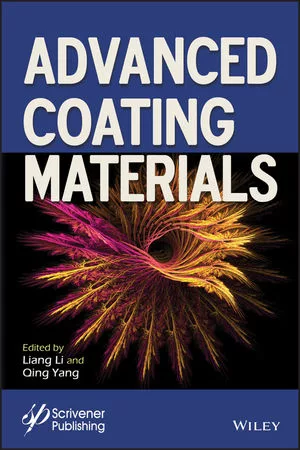Finishing Today's 2006 Innovation Awards
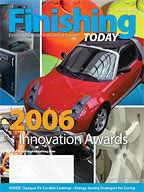
In this issue, we recognize the companies that are changing the landscape of the finishing industry. A survey of recent innovation in the field was conducted over the last few months. Numerous nominations were submitted from a variety of sources. A list of more than 20 technical candidates was reviewed by Finishing Today's editorial advisory board. The board members were instructed to rank the top five candidates they felt represented the most innovative developments over the last year.
In looking for the top innovators, we identified four different aspects of technology: materials, processes, instrumentation and equipment. Finishing Today has found developments worthy of recognition in all four categories. It's an honor and a pleasure to present the winners for 2006.
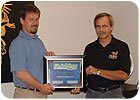
Kevin Biller (left) presents the 2006 Top Innovator Award to Marshall Leininger, CEO of Helios Coatings, Inc.
Top Innovator Award:
Helios Coatings, Inc.'s Metallight Wheel Finishing Technology
The Helios Coatings system is remarkable in many ways. First of all, it marries three distinct technologies to create a product and finishing effect that has been long sought in our industry. In addition, the story of this David in a land of automotive Goliaths is both amazing and uplifting. Its genesis springs forth from a vision by the founder of the process, Marshall Leininger. Marshall has been in the finishing industry for more than 25 years in roles as diverse as a jobcoater and a product manager for a medium sized coating producer. Through the years, he recognized the need for an acceptable replacement for chrome plating on automotive wheels. The metallizing of plastic substrates is a well-developed technology. Some manufacturers have cultivated processes that involved the metallizing of powder coating films for applications other than automotive wheels. The French had metallized powder films for use as headlamp reflectors throughout the 1990s. Leininger felt that he could consolidate the attributes of powder coating, vacuum metallizing and UV cure to produce a chrome-like finish for automotive wheels. To accomplish his vision, he enlisted the services of Seibert Powder Coatings, Red Spot Paint (UV coatings), Advanced Vacuum Systems (vacuum metallizing process), Nutro Corp (turnkey installation), Fusion Systems (UV lamps), GE-Water & Process Technologies (pretreatment) and Anderson Development (powder resins).
The process starts with a clean alloy wheel that sees a nine stage pretreatment process. The wheel is then dried and powder coated with a high distinctness of image (DOI) primer. This primer is baked, sealed with a liquid UV coating and cured with intense UV light. Following the UV cure, the surface of the wheel is vacuum metallized. The thin metallic layer provides an incredibly bright surface. However, this surface will quickly tarnish if left exposed to the atmosphere. It is therefore coated with a high-gloss, automotive-quality clear powder and baked to a hard, scratch-resistant finish.
The resultant finish provides a remarkable coating, both from an aesthetic and performance standpoint. The look achieves the luster of a traditional chrome finish without any environmental detriment. Furthermore, accelerated tests indicate that the Helios process surpasses chrome plating for corrosion resistance.
In the past few months, Helios Coatings, Inc. has significantly increased its production output and is looking to expand the capacity of its plant to meet increasing commercial demand. In the automotive land of gargantuan coating conglomerates, it is refreshing to encounter an enterprising individual realizing his dream. Congratulations, Marshall Leininger and the Helios Coatings team.
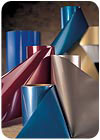
Soliant's Fluorex Exterior Film Laminates
Innovation Award for Process Technology:
Soliant Fluorex, Avery Avloy and GE Lexan SLX Exterior Film Laminates
The award for process technology innovation is shared by Soliant, LLC, Avery Dennison and GE Lexan Group. All three companies have developed and commercialized an alternative to conventional finishing processes for plastic automotive substrates. This technology was developed as an alternative to paint and mold-in-color processes. These exterior film laminates or "dry paint" films are essentially multilayer films that can be thermoformed to a form that is then inserted into an injection mold. The structure of the part is then injection molded behind the film. An alternative process is "thick sheet thermoforming," in which the film laminate is vacuum applied to a form that is subsequently trimmed and then assembled.Besides offering significant process savings and zero volatile organic compounds (VOCs), dry-paint films provide a very high-gloss, Class A surface that can surpass that of paint. In addition, these materials pass all automotive requirements for UV resistance, stone chip performance and resistance to chemical agents. The automotive industry is just beginning to embrace this novel technology for these attributes and some of the unique special effects that can be achieved.
Innovation Award for Materials:
Allied PhotoChemical's Pigmented UV Cure Coatings
The award for innovation in materials goes to Allied
PhotoChemical for its pigmented UV curable coatings. For years, formulators have struggled with developing colorful radiation curable coatings. The nature of radiation cure chemistry makes it difficult to identify pigments and photoinitiators that allow for a thorough cure of a coating layer. If this isn't enough of a challenge, Allied PhotoChemical has taken the technology one step further and has developed a UV curable product line that adheres well to metal substrates. UV curable materials by nature shrink when curing, which makes adhesion to metal problematic. Allied's formulators have cracked the code and are commercially successful with a significant array of aesthetics, including silver metallics, bright colors and glow-in-the-dark electrofluorescents.Environmental friendliness is another key benefit of this technology, because Allied formulates the coatings at 100% solids, zero VOCs and zero hazardous air pollutants (HAPs).
In addition to offering products with hitherto unachieved coating aesthetics and performance, Allied prides itself as promoting a work environment based on honesty, integrity, loyalty and personal growth.
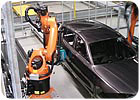
Imaginant, X-Rite and BYK-Gardner's Robotic Coating Quality Measurement System
Innovation Award for Instrumentation:
Imaginant, X-Rite and BYK-Gardner's Robotic Coating Quality Measureme
A joint effort by Imaginant (formerly JSR Ultrasonics), X-Rite and BYK-Gardner wins our Innovation Award for Instrumentation. The adept engineers at these companies developed a robotically mounted apparatus that simultaneously measures coating thickness, color and surface smoothness. Amazing as this seems, it is all accomplished without ever contacting the coating surface. The instrument consists of a head that embodies all three devices. The film thickness is measured using ultrasonic technology developed by Imaginant. Color data is collected utilizing X-Rite's Car-Flash spectrophotometer, and the surface profile is assessed by a Wave Scan instrument provided by BYK-Gardner.This novel technology has been implemented by one of the world's most prestigious automakers on its assembly lines. Film thickness is measured 40 times in 11 seconds, color 13 times in 10 seconds, and the surface profile is measured 25 times in 14 seconds. All data is recorded and retained in a central database. Using this technology, finishing processes can be monitored and optimized. Finishing experts expect this technology to eventually become the norm across the entire automotive industry.
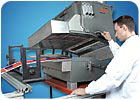
Advanced Electron Beam's Emitters
Innovation Award for Equipment:
Advanced Electron Beam's Emitters
Advanced Electron Beam (AEB) wins the Innovation Award for Equipment Technology. For years, coating technologists have recognized the advantages of using electron beam (EB) energy to polymerize paint. Although conventional EB technology has a number of advantages over possible alternatives, it has historically suffered from the major commercial disadvantage that the systems were large, expensive and difficult to maintain. In particular, EB systems have, until now, required vacuum pumping equipment, large high voltage power supplies and complex shielding, as well as in-plant engineering and maintenance expertise. As a result, it has not been easy or sometimes possible at all to integrate the systems into manufacturing equipment.AEB has developed a simple and ingenious electron beam emitter contained in a sealed unit. The technology is scalable and can be used to produce emitters in a variety of sizes. AEB currently produces a 10-in. and 16-in. model, which can be aligned in multiples to produce a beam of any desired width. The units have an operating voltage of 80-150 kV and weigh less than 30 lb. The emitter's small size allows it to be easily integrated into existing manufacturing and production equipment. This unique technology will likely open the doors for numerous commercial developments in high-speed coating applications.
Looking for a reprint of this article?
From high-res PDFs to custom plaques, order your copy today!




